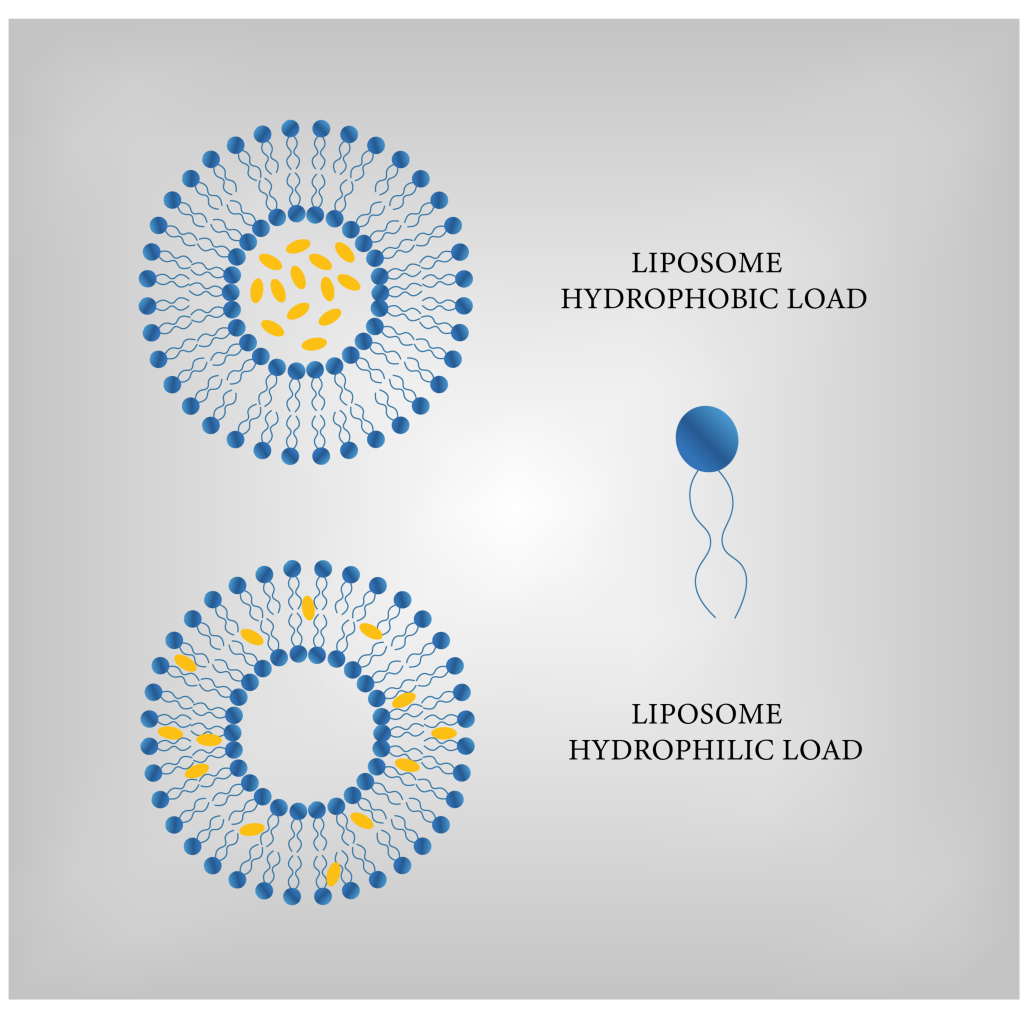The liposome
The word liposome is derived from two Greek words lipo and soma, translating into fat and body, respectively. Liposomes are lipid-based vesicles consisting of at least one lipid bilayer, used primarily to encapsulate bioactive compounds to enhance bioavailability.
Liposomes are also very useful models for cell membrane research due to their striking similarities with the membranes of many of our bodily cells. For this reason, liposomes are often used as artificial cells.
The liposome structure is made from lecithin which contains the necessary phospholipids, including phosphatidylcholine, for the formation of liposomal structures. Phospholipids have both a “head” end and a “tail” end.
When placed in a water-based medium these phospholipids join together and form aggregates. This creates two parallel, opposite facing rows of phospholipids. The heads make up the inner and outer surface of the membrane, whilst the tails compose the membrane core.
Liposomes are attractive encapsulation systems that provide enhanced stability of encapsulated materials against a range of environmental, enzymatic, and chemical stresses. These may include the presence of enzymes or reactive chemicals, and exposure to extreme pH, temperature, and ionic strength changes.
Liposomes have been widely used in the pharmaceutical and food industries because of their biocompatibility and biodegradability. Their absence of toxicity, small size, and ability to carry a wide variety of bioactive compounds, due to the amphiphilicity of the phospholipid encapsulating material, make them a popular delivery agent.
Due to the polarising properties of phospholipids, the core structural materials for liposomes, liposomes encapsulate both fat-soluble and water-soluble bioactives.
Since liposomes are made in water, during formation they encapsulate a percentage of their environment.
If there are water soluble bioactives present then the developing liposomes encapsulate the bioactive in the water-based core. If the compound is fat soluble, it will instead integrate itself inside the liposomal membrane, within the tails of the phospholipid bilayer.
Food Supplements
In today’s fast-paced, health conscious society, food supplements are an increasingly popular, convenient source of nutrition, with data published by the HFMA at the beginning of 2021 reporting that the number of daily supplement users in the UK now sits at almost 20 million – up 19% since the last survey in 2019.
Over 71% of adults are taking food supplements with one in three claiming that the pandemic was the catalyst.
However, just because we take supplements on a regular basis, it does not necessarily mean we are absorbing the nutrients on the label.
Orally administered vitamins typically show low absorption or bioavailability, due to their degradation by enzymes in the gastrointestinal (GI) tract, the difficulty of absorbing them in the small intestine and the first-pass metabolism in the liver.
In reality, traditional oral vitamins and micronutrients lose the majority of their potency through digestion, metabolism and excretion, prior to reaching the cells in our body.

Liposomal Food Supplements
Oral liposomes, like food particles, travel down the intestinal tract through the stomach and into the small intestine where they are mainly absorbed.
The gastrointestinal tract is lined with a layer of mucus which covers finger-like projections called villi. A microscopic focus on these villi reveals they are lined with a monolayer of epithelial cells. These are called enterocytes, which are further coated with smaller protrusions called microvilli.
Digested food constituents, including liposomes, must cross these enterocytes before they can enter the liver or the bloodstream where they can then be used by the body. In addition to the enterocytes there are a number of specific mechanisms by which liposomes are absorbed by the cells of intestinal tract.
Cell transport mechanisms such as simple transcellular absorption via diffusion, fusion, lipid endocytosis and receptor mediated endocytosis of liposomes into normal enterocytes are the primary ways in which liposomes will be absorbed from the gastrointestinal tract.
Liposome Superiority
By their very nature, liposomes have the extraordinary advantage of being able to carry a wide range of compounds. Liposomes are therefore the ideal, and far superior method, for effectively delivering nutrients.
Liposomes are designed not only to protect the nutritional supplement from degrading in the harsh environment of the gut terrain but also to deliver the nutrients in a targeted manner.
Unparalleled Knowledge
SAIFx® Encapsulation Technology distinguishes our liposomal products from those of other companies, ensuring an unparalleled user experience. Leveraging our advanced smaller, stable, single-layer spheres, crafted from the highest quality ingredients available, our liposomal delivery systems represent a significant enhancement over conventional liposomal technology.
The distinction is demonstrably clear; our liposomal products exhibit a transparency that is achievable only with liposomes engineered to be sufficiently small to traverse cellular barriers and enter the bloodstream post-ingestion, thereby maximising bioavailability.
